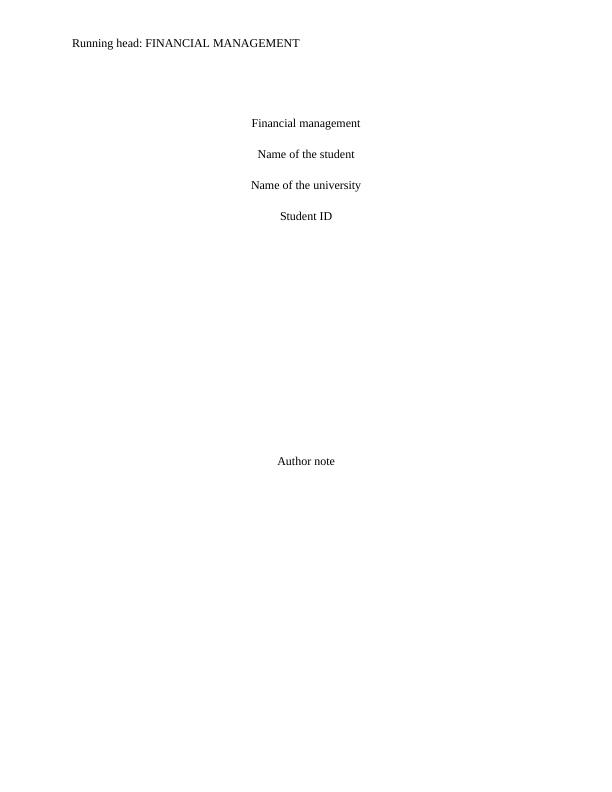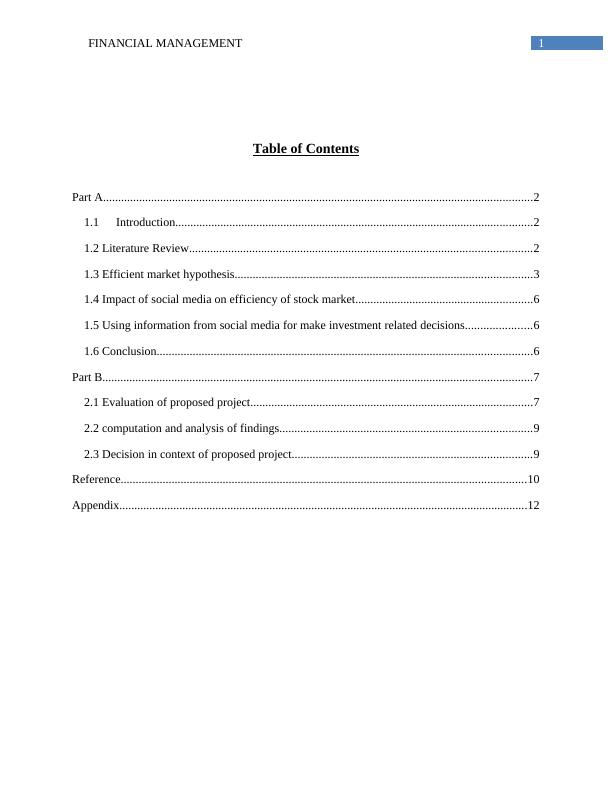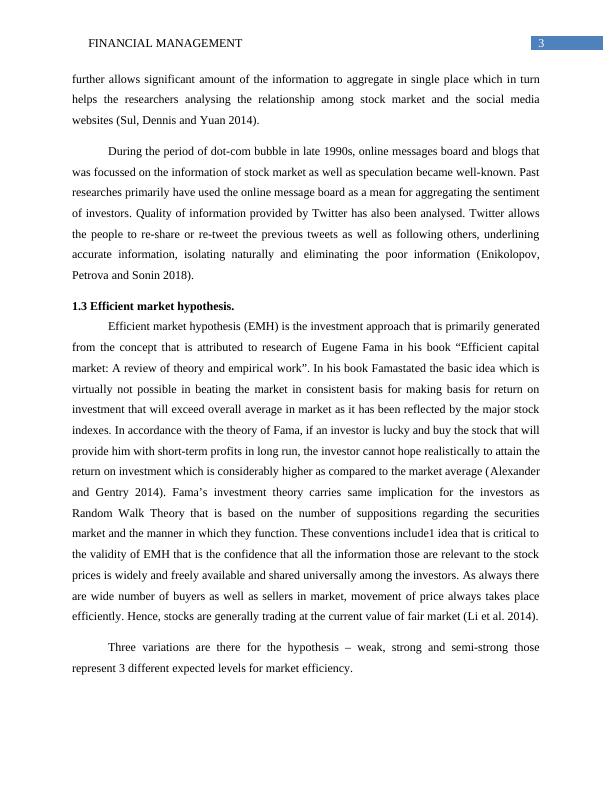Facebook provided the researchers with investigation
The article explores the impact of social media sentiment on stock market performance and discusses the effectiveness of using microblog messages to predict market trends.
13 Pages3767 Words12 Views
Added on 2022-09-02
Facebook provided the researchers with investigation
The article explores the impact of social media sentiment on stock market performance and discusses the effectiveness of using microblog messages to predict market trends.
Added on 2022-09-02
ShareRelated Documents
Running head: FINANCIAL MANAGEMENT
Financial management
Name of the student
Name of the university
Student ID
Author note
Financial management
Name of the student
Name of the university
Student ID
Author note

1FINANCIAL MANAGEMENT
Table of Contents
Part A...............................................................................................................................................2
1.1 Introduction.......................................................................................................................2
1.2 Literature Review..................................................................................................................2
1.3 Efficient market hypothesis...................................................................................................3
1.4 Impact of social media on efficiency of stock market...........................................................6
1.5 Using information from social media for make investment related decisions......................6
1.6 Conclusion.............................................................................................................................6
Part B...............................................................................................................................................7
2.1 Evaluation of proposed project..............................................................................................7
2.2 computation and analysis of findings....................................................................................9
2.3 Decision in context of proposed project................................................................................9
Reference.......................................................................................................................................10
Appendix........................................................................................................................................12
Table of Contents
Part A...............................................................................................................................................2
1.1 Introduction.......................................................................................................................2
1.2 Literature Review..................................................................................................................2
1.3 Efficient market hypothesis...................................................................................................3
1.4 Impact of social media on efficiency of stock market...........................................................6
1.5 Using information from social media for make investment related decisions......................6
1.6 Conclusion.............................................................................................................................6
Part B...............................................................................................................................................7
2.1 Evaluation of proposed project..............................................................................................7
2.2 computation and analysis of findings....................................................................................9
2.3 Decision in context of proposed project................................................................................9
Reference.......................................................................................................................................10
Appendix........................................................................................................................................12

2FINANCIAL MANAGEMENT
Part A
1.1 Introduction
Boom of the social media in past decades has changed the manner in which the investors
forecast stock market. As the social media offers wide volumes of the real time opinion for the
users, investors potentially can exploit the information through leveraging the processing
technique of machine learning as well as natural language. In recent times, repeatedly popular
news channels are reporting that predicting market through alternative data like micro-blog
messages are becoming the mainstream among the institutional investors. Generally the investors
always look for gaining the edge on rest of the market. As per the traditional market theory
predicting the future movement for stock market is wasted effort. Growth in popularity and size
of social media sites such as Twitter and Facebook provided the researchers with investigation
regarding science for predicting another source for data (Paniagua and Sapena 2014)
1.2 Literature Review
Drawing on the theories as well as prior findings in context of behavioural finance, it is
believed that when the sentiments of investors may forecast the returns on the future stocks, it is
also expected to be impacted through the returns of past stocks. It means that the potential
casualty circleamong stock returns and micro-blog sentiment such casualty circle shall be taken
into consideration under analysis.Twitter became the well-known website that that allows more
than 500 million members sending average of 340 million tweets daily all of which include more
or less 140 characters. In recent times, investors in the stock market have turned to the Twitter as
the investment tool. Appeal of Twitter as an investment pool lies in the ability of the users in
relaying the information regarding the entity, ideas for investment and market sentiment in
concise and short manner (Liu et al. 2015). At present, investors generally turn to website of
StockTwits for sharing the information. StockTwits that was developed in 2008 boasts 300,000
investors, public entities and market professional those use this site for sharing information and
ideas regarding the market as well as individual stocks. StockTwit is the platform like Twitter
that is focused on the investors and operates in the similar way. Generally the users share short
messages regarding particular index or stock applying the $ symbol before the ticker symbol that
allows the StockTwit organizing information or streams regarding particular index or stock. It
Part A
1.1 Introduction
Boom of the social media in past decades has changed the manner in which the investors
forecast stock market. As the social media offers wide volumes of the real time opinion for the
users, investors potentially can exploit the information through leveraging the processing
technique of machine learning as well as natural language. In recent times, repeatedly popular
news channels are reporting that predicting market through alternative data like micro-blog
messages are becoming the mainstream among the institutional investors. Generally the investors
always look for gaining the edge on rest of the market. As per the traditional market theory
predicting the future movement for stock market is wasted effort. Growth in popularity and size
of social media sites such as Twitter and Facebook provided the researchers with investigation
regarding science for predicting another source for data (Paniagua and Sapena 2014)
1.2 Literature Review
Drawing on the theories as well as prior findings in context of behavioural finance, it is
believed that when the sentiments of investors may forecast the returns on the future stocks, it is
also expected to be impacted through the returns of past stocks. It means that the potential
casualty circleamong stock returns and micro-blog sentiment such casualty circle shall be taken
into consideration under analysis.Twitter became the well-known website that that allows more
than 500 million members sending average of 340 million tweets daily all of which include more
or less 140 characters. In recent times, investors in the stock market have turned to the Twitter as
the investment tool. Appeal of Twitter as an investment pool lies in the ability of the users in
relaying the information regarding the entity, ideas for investment and market sentiment in
concise and short manner (Liu et al. 2015). At present, investors generally turn to website of
StockTwits for sharing the information. StockTwits that was developed in 2008 boasts 300,000
investors, public entities and market professional those use this site for sharing information and
ideas regarding the market as well as individual stocks. StockTwit is the platform like Twitter
that is focused on the investors and operates in the similar way. Generally the users share short
messages regarding particular index or stock applying the $ symbol before the ticker symbol that
allows the StockTwit organizing information or streams regarding particular index or stock. It

3FINANCIAL MANAGEMENT
further allows significant amount of the information to aggregate in single place which in turn
helps the researchers analysing the relationship among stock market and the social media
websites (Sul, Dennis and Yuan 2014).
During the period of dot-com bubble in late 1990s, online messages board and blogs that
was focussed on the information of stock market as well as speculation became well-known. Past
researches primarily have used the online message board as a mean for aggregating the sentiment
of investors. Quality of information provided by Twitter has also been analysed. Twitter allows
the people to re-share or re-tweet the previous tweets as well as following others, underlining
accurate information, isolating naturally and eliminating the poor information (Enikolopov,
Petrova and Sonin 2018).
1.3 Efficient market hypothesis.
Efficient market hypothesis (EMH) is the investment approach that is primarily generated
from the concept that is attributed to research of Eugene Fama in his book “Efficient capital
market: A review of theory and empirical work”. In his book Famastated the basic idea which is
virtually not possible in beating the market in consistent basis for making basis for return on
investment that will exceed overall average in market as it has been reflected by the major stock
indexes. In accordance with the theory of Fama, if an investor is lucky and buy the stock that will
provide him with short-term profits in long run, the investor cannot hope realistically to attain the
return on investment which is considerably higher as compared to the market average (Alexander
and Gentry 2014). Fama’s investment theory carries same implication for the investors as
Random Walk Theory that is based on the number of suppositions regarding the securities
market and the manner in which they function. These conventions include1 idea that is critical to
the validity of EMH that is the confidence that all the information those are relevant to the stock
prices is widely and freely available and shared universally among the investors. As always there
are wide number of buyers as well as sellers in market, movement of price always takes place
efficiently. Hence, stocks are generally trading at the current value of fair market (Li et al. 2014).
Three variations are there for the hypothesis – weak, strong and semi-strong those
represent 3 different expected levels for market efficiency.
further allows significant amount of the information to aggregate in single place which in turn
helps the researchers analysing the relationship among stock market and the social media
websites (Sul, Dennis and Yuan 2014).
During the period of dot-com bubble in late 1990s, online messages board and blogs that
was focussed on the information of stock market as well as speculation became well-known. Past
researches primarily have used the online message board as a mean for aggregating the sentiment
of investors. Quality of information provided by Twitter has also been analysed. Twitter allows
the people to re-share or re-tweet the previous tweets as well as following others, underlining
accurate information, isolating naturally and eliminating the poor information (Enikolopov,
Petrova and Sonin 2018).
1.3 Efficient market hypothesis.
Efficient market hypothesis (EMH) is the investment approach that is primarily generated
from the concept that is attributed to research of Eugene Fama in his book “Efficient capital
market: A review of theory and empirical work”. In his book Famastated the basic idea which is
virtually not possible in beating the market in consistent basis for making basis for return on
investment that will exceed overall average in market as it has been reflected by the major stock
indexes. In accordance with the theory of Fama, if an investor is lucky and buy the stock that will
provide him with short-term profits in long run, the investor cannot hope realistically to attain the
return on investment which is considerably higher as compared to the market average (Alexander
and Gentry 2014). Fama’s investment theory carries same implication for the investors as
Random Walk Theory that is based on the number of suppositions regarding the securities
market and the manner in which they function. These conventions include1 idea that is critical to
the validity of EMH that is the confidence that all the information those are relevant to the stock
prices is widely and freely available and shared universally among the investors. As always there
are wide number of buyers as well as sellers in market, movement of price always takes place
efficiently. Hence, stocks are generally trading at the current value of fair market (Li et al. 2014).
Three variations are there for the hypothesis – weak, strong and semi-strong those
represent 3 different expected levels for market efficiency.

End of preview
Want to access all the pages? Upload your documents or become a member.
Related Documents
Assignment : Social Medialg...
|8
|2045
|81
Social Media Technologies: Advantages and Disadvantages in Recruitmentlg...
|11
|2898
|390
Twitter's Strategic Decision-Making Model - Part A: Analysis of the Ashridge Sense of Mission Modellg...
|11
|2680
|422
Forecasting Stock Prices in International Marketslg...
|8
|1325
|442
PRO 285 : Public Relations in Society - Murdoch Universitylg...
|8
|1513
|281
Social Media Impact on Organizations, Business and Communicationlg...
|15
|609
|155
